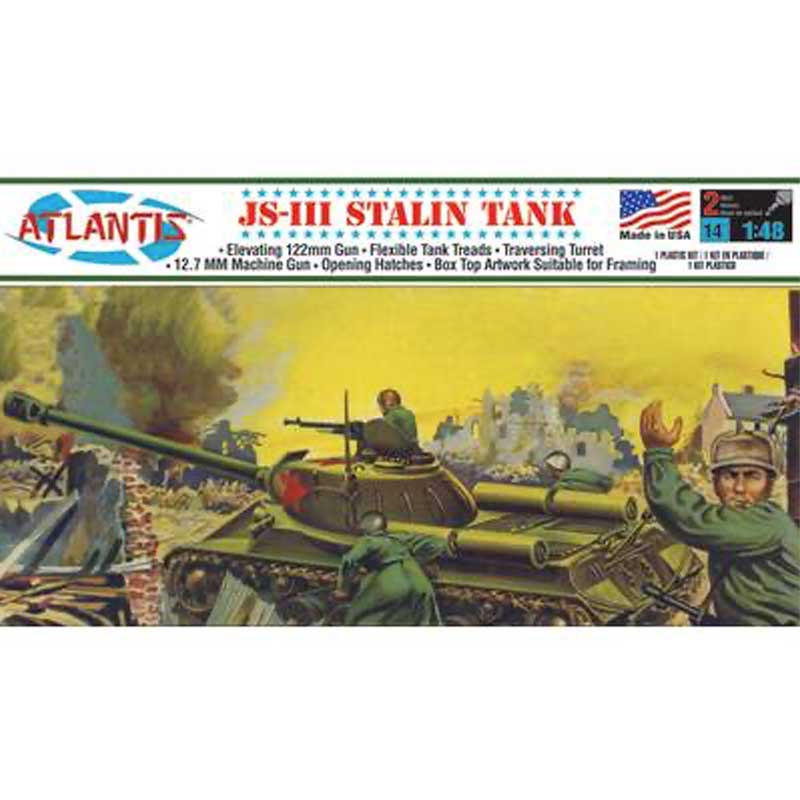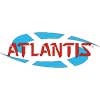£25.99 Original price was: £25.99.£23.39Current price is: £23.39.
1/48 Russian Stalin Tank CA303 Atlantis Models
In stock
Key Features
Elevating 122mm gun
Flexible tank treads
Traversing turret
12.7mm machine gun
Opening hatches
Box top artwork suitable for framing
Made in the USA
Aurora tooling
Product Description
1/48 Scale. Features elevating 122mm gun, flexible tank treads, traversing turret, 12.7 MM machine gun, opening hatches, Moulded in Russian green.
In 1943 the Russians developed the famous T-34 tank which did much to help drive the Nazis from their homeland. The T-34 was heavily armoured and mounted a large caliber gun in a single 360-degree traverse turret. This tank set the pattern for future Russian tank design and strongly influenced foreign designs including the world-famous Panther Tank produced by Germany during World War II. The Panther copied much from the T-34 and the Germans developed these ideas into an even better fighting machine. With the introduction of the T-34, the large gun, heavy tank race was on. The Russians, utilising the experience gained with the T-34 design, came out with the KV-2, a 52 ton, 76mm gun tank which was quickly followed by the first of the Stalin Tank series, the JS-1. This new design was a 57 ton 122mm gun tank which first appeared in 1945 and was improved in the following years to produce the Joseph Stalin III.
The JS-III Tank incorporated two conspicuous departures in armour design that were entirely new in tanks. The first is a prow-shaped front hull, technically called compound obliquity. A shell striking the front of the tank must, because of the sharply angled plates, penetrate a thicker section of armour than would be encountered in a flat vertical plate. The second radical feature is the turret, which is the first turtle-back design on a standard tank. Because it is cast in steel with varying wall thicknesses, this type of turret affords greater protection against high velocity anti-tank shells at a substantial savings in weight, while still being sufficiently protected on the top surface.
The JS-III mounts a high-velocity 122mm cannon which fires a 50 lb. shell. Because of the size of these shells, not many can be carried in the closely-packed turret. Another disadvantage of this gun is that the shells are hand-fed into the breach. A slower rate of fire is affected by this, and this is critical when the first few rounds of a tank battle count. The only other armament on the JS-III Tank is the 12.7mm DSHK machine gun mounted on top of the turret in front of the Commander’s hatch. Periscopes are provided for both driving and observation to cut down the number of openings into the interior, and all steering instructions are radioed from the Commander’s hatch.
The JS-III is powered by a 60-degree V-type 12 cylinder, liquid-cooled diesel engine which gives the tank a top speed of 20 miles per hour. The tracks are large and widely spaced, exerting 11.6 pounds per square inch making it possible for the JS-III to cross over soft ground that would bog down even lighter, smaller tanks.
- Royal Mail Tracked (Standard)** (£3.89) 2-3 Working Days***
- Royal Mail Tracked (Express)** (£5.99) 1-2 Working Days***
- FedEx (£8.99) Next Working Day***
- Free – 2-6 Working Days*
** Limited to maximum weight of 2kg *** These are not guaranteed delivery times and delays are possible
*Free delivery is subject to restrictions, orders between £60-£99.99 containing products that can only shipped with Royal Mail. Orders that include products like aerosols, large quantity of flammable products or over maximum size and weight allowed by Royal Mail will not be sent free and are subject to a carriage charge, Orders over £100 are not subject to restrictions and apply to UK Mainland only. Orders containing hazardous or oversized goods cannot be shipped to NI, IOM, IOW, Highlands, these are excluded from our free shipping.
Order cutoff times - Monday 11am, Tuesday to Friday 12pm.
Order processing days Monday-Friday
Working days are Monday to Friday and do not include weekends


